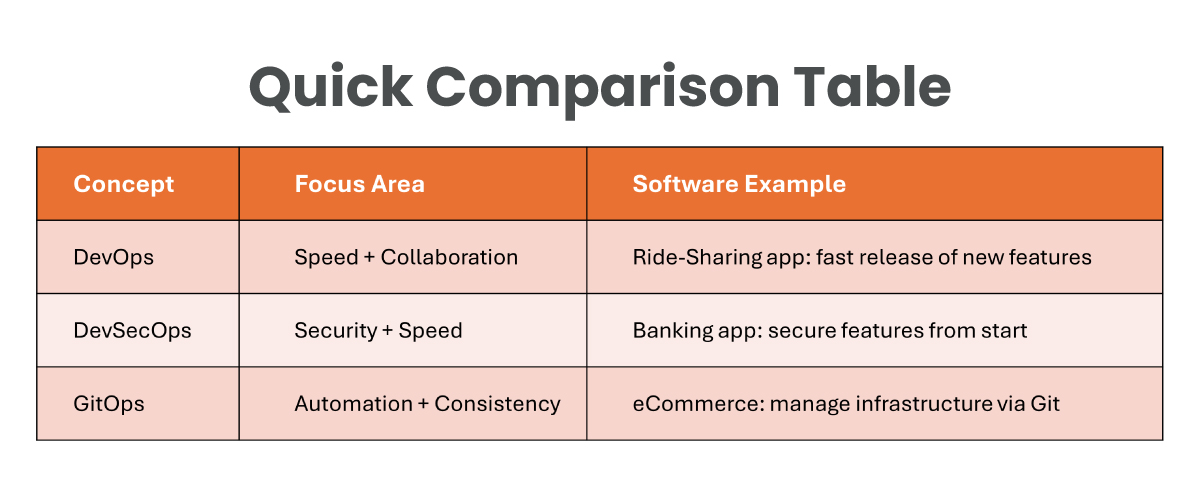DevOps vs DevSecOps vs GitOps : What's the Difference and Why it Matters
DevOps
– 6 Min Read
DevOps
– 6 Min Read
Every company that builds software faces the same question: how do we ship faster, safer and with less chaos? The answer isn’t just better code — it’s better systems.
That’s where DevOps, DevSecOps, and GitOps come in. These aren’t interchangeable buzzwords. They’re distinct operating models that define how your team collaborates, automates and scales.
This guide cuts through the jargon to give you clarity on these powerful methodologies, their key differences, and how they can transform your software development lifecycle.
DevOps emerged around 2009 as a response to the traditional siloed approach where development and operations teams worked independently, often with conflicting goals. Developers wanted to push new features fast, while operations prioritized stability and uptime.
DevOps resolves this fundamental conflict by creating a culture of collaboration, shared responsibility, and automation across the entire software delivery pipeline.
Imagine you’re developing a ride-sharing app. In the past, your developers would write code, throw it “over the wall” to operations, and hope it runs.
With DevOps, your developers and operations team work together from day one. They set up automated pipelines, test environments, and monitoring tools. When a new feature like “Add Wallet” is developed, it’s automatically tested, deployed, and monitored—fast, reliable, and smooth for users.
As DevOps became popular, a critical piece was often forgotten or bolted on as an afterthought: security. Traditional security processes were designed for the waterfall era, with security checks at the end of development.
DevSecOps evolved to address this gap by integrating security practices into the DevOps pipeline, making security a shared responsibility from day one.
Let’s say you’re building a mobile banking app. You can’t afford to launch first and then worry about things like password leaks, insecure APIs, or compliance issues.
With DevSecOps, security tools are part of your development pipeline. Code is scanned for vulnerabilities automatically. Secrets like API keys are flagged before they’re pushed. You release features like “Biometric Authentication Module” or “Fund Transfer” quickly—but safely.
GitOps is a newer concept introduced by Weaveworks in 2017. While DevOps is a broad methodology encompassing culture and processes, GitOps is a specific implementation approach that uses Git repositories as the single source of truth for infrastructure and applications.
In GitOps, changes to infrastructure and applications are made through pull requests to a Git repository, not directly to the runtime environment.
Your eCommerce site is booming during the holiday season. You need more servers to handle traffic, and you want every server configured exactly the same.
With GitOps, your entire infrastructure setup lives in a Git repository. You just update a configuration file (say, increase server count), and automation does the rest—provisioning, syncing, and verifying everything. No need to manually SSH or click buttons.

DevOps Tools (Focus: Automation, CI/CD, Collaboration)
DevSecOps Tools (Focus: Security Across Pipeline)
GitOps Tools (Focus: Declarative Infrastructure)
You don’t have to choose between DevOps, DevSecOps and GitOps. Many organizations implement elements of all three, tailored to their needs:
Many organizations find the optimal solution is a combination of all three:
This integrated approach gives you a complete framework for delivering secure software fast.
DevOps, DevSecOps and GitOps aren’t competing methodologies but complementary approaches to different aspects of the software delivery lifecycle. The most successful companies view these as parts of a holistic approach to building and deploying software.
As you evaluate which approach is right for your company, remember the goal isn’t to implement a methodology for its own sake but to solve business problems and create competitive advantages. Start with your objectives, assess your current state, and build a roadmap that includes the most relevant elements of each.
Yes, GitOps is an extension of DevOps, focused on infrastructure management through Git.
No, DevSecOps builds on top of DevOps by integrating security into development and operations.
DevSecOps is designed specifically to integrate security into every stage of development.